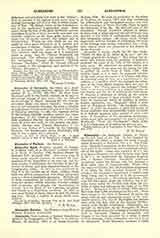

Alexandre, DOM JACQUES, a learned Benedictine monk of the Congregation of St. Maur, b. at Orleans, France, January 24, 1653; d. at Bonne-Nouvelle, June 23, 1734. He made his profession in the abbey of Vendome, August 26, 1673, and after completing his philosophical and theological studies, was sent to the monastery of Bonne-Nouvelle, where he spent the remainder of his life. He died subprior of the monastery. Though somewhat delicate in health, he was a man of great industry and all his leisure was devoted to the study of mathematics and physical and mechanical science. He wrote much, though apparently without thought of publication, for most of his writings were merely transcribed into a large folio volume which was preserved in the library of Bonne-Nouvelle.
Alexandre is known chiefly by his two works, “Traite du flux et du reflux de la mer” and the “Traite general des horloges.” The former had already been written when the Academy of Bordeaux proposed the cause of the tides as the subject of a prize essay. He submitted an extract which was deemed worthy of the prize and his success led him to publish the entire work at Paris, 1726. This treatise, based as it is upon the supposed rotation of the earth about the moon, is of interest only from an historical point of view, as a contribution to the solution of a problem which has engaged the attention of the most skillful analysts since the time of Newton. The “Traite general des horloges”, Paris, 1734, as its name indicates, is a general treatise on the history and the art of constructing timepieces. It contains a catalogue of writers on the subject with a brief account of their principal works. Besides his manuscript works on subjects in mathematics, mechanics, etc., Alexandre added a sixth part to Huyghen’s treatise “De horologio oscillatorio”, in which he describes a clock the length of whose pendulum was automatically varied to enable it to indicate apparent solar instead of mean solar time. A description of the pendulum mechanism, which never came into practical use, may be found in Berthoud’s “Essai sur l’horlogerie”, Paris, 1786, I, xvii, where some of its defects are pointed out.
H. M. BROCK

